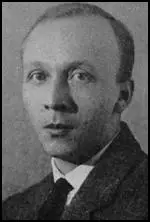Erhard Heiden

Erhard Heiden was born in Weiler, Germany, on 23rd February 1901. He joined the National Socialist German Workers Party (NSDAP) and was also a member of the Sturmabteilung (SA).
Adolf Hitler decided he needed his own personal bodyguard and on 9th November, 1925 the Schutzstaffel (SS) was formed. The word Schutzstaffel means "defence echelon". As Louis L. Snyder has pointed out: "The name was universally abbreviated to SS, not in Roman or Gothic letters but written as a lightening flash in imitation of ancient runic characters. The SS was known as the Black Order." Julius Schreck became its first leader and he was told that the SS was an independent organization alongside, but subordinate to, the SA.
Schreck resigned as Reichführer-SS in 1926 and was replaced by Joseph Berchtold, with Heiden as his deputy. In September 1927 Berchtold issued SS Order No. 1. This instructed SS men not to become involved in discussion at party meetings, and that discussion evenings were for the purpose of political instruction only, during which SS men should not smoke, nor leave the room until the lecture was over. SS men were also told that they must at all times carry their NSDAP membership card, his SS card and the SS songbook. Since the SS was anxious to promote an impression of legality and order, members were forbidden to carry arms.
Berchtold resigned in 1927 and was replaced by Heiden. Under Heiden’s leadership the SS declined in membership from 1000 to 280. Heiden hired Heinrich Himmler to serve as his deputy. Heiden fell into disgrace after allegations surfaced that parts of his uniform were customized by a Jewish tailor. On 5th January 1929 he was dismissed by Adolf Hitler and succeeded by Himmler as Reichsführer-SS.
Erhard Heiden was arrested in April 1933 on the orders of Himmler. His body was found in September 1933.
Primary and Secondary Sources
(1) Andrew Mollo, To The Death's Head: The Story of the SS (1982)
Although mostly unemployed, SS men were expected to provide their own uniforms which also differed from those of the SA. SS men wore the brown shirt but, unlike the SA, they had a black cap adorned with a silver death's head, a black tie and black breeches, and the swastika armband was withdrawn from SS men who had infringed minor regulations.
